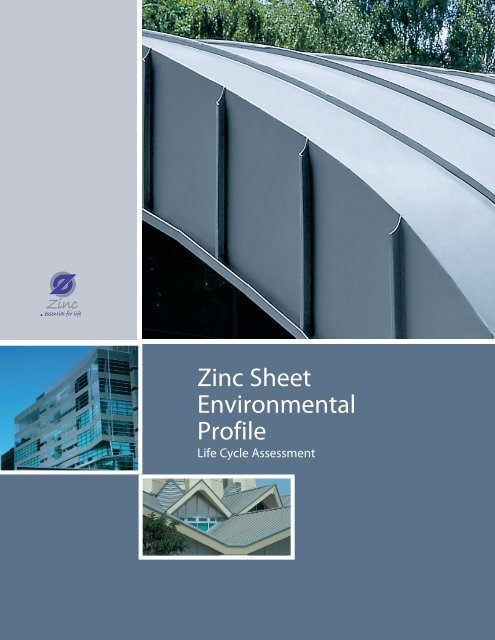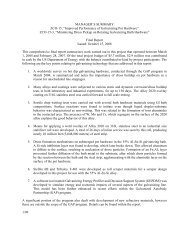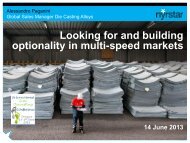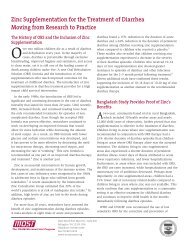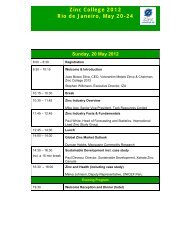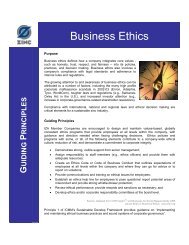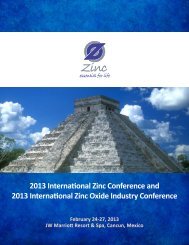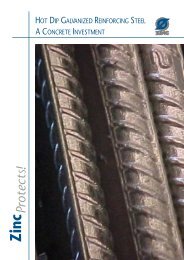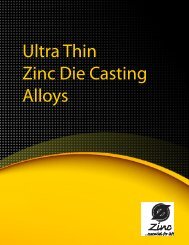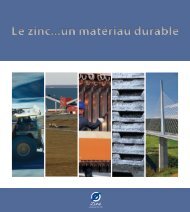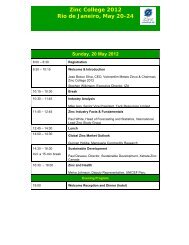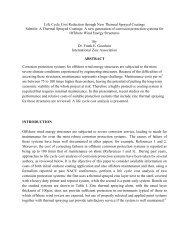Zinc Sheet Environmental Profile - Life Cycle Assessment
Zinc Sheet Environmental Profile - Life Cycle Assessment
Zinc Sheet Environmental Profile - Life Cycle Assessment
Create successful ePaper yourself
Turn your PDF publications into a flip-book with our unique Google optimized e-Paper software.
<strong>Zinc</strong> <strong>Sheet</strong><br />
<strong>Environmental</strong><br />
<strong>Profile</strong><br />
<strong>Life</strong> <strong>Cycle</strong> <strong>Assessment</strong>
<strong>Zinc</strong> <strong>Sheet</strong><br />
<strong>Environmental</strong> <strong>Profile</strong><br />
<strong>Life</strong> <strong>Cycle</strong> <strong>Assessment</strong><br />
Introduction<br />
Increasingly the zinc industry is being asked to provide<br />
information to downstream users of zinc and zinc-containing<br />
products on the environmental footprint of the materials it<br />
produces. Material specifiers and product engineers in key enduse<br />
markets such as building , construction and transportation<br />
are more and more interested in selecting materials that have the<br />
best environmental profile while meeting traditional cost, quality<br />
and technical performance criteria.<br />
Understanding the environmental footprint of zinc sheet starts<br />
with documenting the resource requirements (energy and nonenergy)<br />
and environmental releases associated with zinc mining<br />
and refining, but it also involves understanding the impacts and<br />
the benefits of the applications and end-of-life fate of zinc sheet.<br />
These benefits can arise in use (e.g. extending the life of roofs<br />
made from zinc sheet) and through end-of-life recycling (e.g.<br />
RHEINZINK reports that 95% of its products are recycled into new<br />
products).<br />
The zinc sheet industry understands that to properly<br />
demonstrate the sustainability attributes of its products, data<br />
and information is needed that enables users of zinc sheet to<br />
evaluate its impacts and benefits across the life cycle (from raw<br />
material extraction to end-of-life recycling). This environmental<br />
profile was developed to provide information and life cycle data<br />
on zinc sheet, and it can be used to understand, and where<br />
appropriate, improve the life cycle impacts and benefits of zinc<br />
sheet products. The profile is based on a life cycle inventory<br />
dataset that can be found in the European <strong>Life</strong> <strong>Cycle</strong> Database at<br />
http://lca.jrc.ec.europa.eu/lcainfohub/datasetArea.vm.<br />
It is important to note that data this profile is based on should be<br />
used as a building block in LCA studies where the entire life cycle<br />
of a zinc sheet product is considered. Without considering the<br />
whole life cycle, meaningful comparisons with other materials<br />
are not possible; hence this information on its own should not be<br />
used to support comparisons between products.<br />
What is zinc sheet, and how is it<br />
used?<br />
<strong>Zinc</strong> is a naturally occurring metal which is found in large<br />
quantities in the form of ore in the earth’s crust. <strong>Zinc</strong> sheet is<br />
made by combining zinc with alloying elements (e.g. copper,<br />
titanium and aluminum), and it is formed into zinc sheet using a<br />
continuous casting/rolling process.<br />
<strong>Zinc</strong> sheet is used extensively in the building industry for roofing,<br />
cladding, flashing and weathering applications. Architectural<br />
alloys generally contain copper and titanium and are produced<br />
and used in the form of sheet, strip, plate and rods, or cut and<br />
formed to desired shapes, such as gutters, cornices and pipes.<br />
<strong>Zinc</strong> sheet is also used in graphic art to make plates, blocks,<br />
battery cans and coinage.<br />
2 <strong>Zinc</strong> <strong>Sheet</strong> <strong>Environmental</strong> <strong>Profile</strong><br />
<strong>Life</strong> <strong>Cycle</strong> <strong>Assessment</strong>
What are the sustainability aspects<br />
of zinc sheet?<br />
<strong>Zinc</strong> sheet has a number of attributes that make it desirable for<br />
a range of applications. It is durable; for example, roofs made<br />
from zinc sheet can last for centuries. It is 100% recyclable, and<br />
for major applications such as roofing and wall claddings, the<br />
recycling rate reaches 95%. This high recycling rate means when<br />
recycled zinc is added to the smelting process, it significantly<br />
reduces the impacts of the production of the zinc used in zinc<br />
sheet. <strong>Zinc</strong> is also aesthetically pleasing, which means it is less<br />
likely to be replaced before needed.<br />
<strong>Zinc</strong> sheet has also been shown to provide shielding properties<br />
that can reduce electromagnetic radiation exposure.<br />
How is zinc sheet produced?<br />
<strong>Zinc</strong> sheet is primarily made of zinc, and details on the production<br />
of primary zinc are shown in the <strong>Zinc</strong> <strong>Environmental</strong> <strong>Profile</strong><br />
available at www.zincforlife.org.<br />
Today zinc sheet is typically produced by continuous casting and<br />
rolling (Figure 1). The main steps are described below.<br />
Special High Grade <strong>Zinc</strong><br />
<strong>Zinc</strong> Scrap<br />
Alloying Elements (Cu, Ti, Al)<br />
Melting<br />
and<br />
Alloying<br />
Casting<br />
Energy, Fuel and Ancillary Inputs<br />
Cooling and<br />
Rolling<br />
Figure 1:<br />
<strong>Zinc</strong> <strong>Sheet</strong><br />
Production<br />
Slitting and<br />
Packaging<br />
<strong>Zinc</strong> <strong>Sheet</strong><br />
<strong>Zinc</strong> <strong>Sheet</strong> <strong>Environmental</strong> <strong>Profile</strong><br />
<strong>Life</strong> <strong>Cycle</strong> <strong>Assessment</strong><br />
3
Alloying<br />
<strong>Zinc</strong> sheet production consists of melting the pure<br />
metal deposited on the cathodes during the electrolysis<br />
process and adding a controlled amount of alloying<br />
elements (copper, titanium and aluminum) in a series of<br />
induction furnaces to produce a liquid alloy.<br />
Casting<br />
The liquid metal is transferred to a casting machine<br />
where it is solidified into a slab, about twelve millimeters<br />
thick and approximately one meter wide. The controlled<br />
cooling process within the machine produces a fine,<br />
homogeneous grain structure.<br />
Rolling<br />
Three to five rolling operations are typically performed<br />
to reduce the slab to the desired thickness. Throughout<br />
this process, temperature, rolling speed and reduction<br />
rate are closely monitored and adjusted to obtain the<br />
requisite mechanical and dimensional characteristics.<br />
Slitting and Packaging<br />
The final stage involves slitting the rolled zinc into sheets<br />
or coils of the requisite weight, width and thickness on<br />
specialized finishing lines.<br />
There are four components to a typical LCA study:<br />
Goal and Scope – where the reference units, scope and<br />
boundaries, audience and uses of the study are confirmed;<br />
<strong>Life</strong> <strong>Cycle</strong> Inventory – where the physical system is modeled<br />
and data is collected on all relevant inputs and outputs to the<br />
system;<br />
<strong>Life</strong> <strong>Cycle</strong> Impact <strong>Assessment</strong> – where potential impacts<br />
associated with the system being studied are assessed; and<br />
Interpretation – where the results are interpreted to help<br />
decision-makers understand where the greatest impacts are and<br />
to determine the implications of changes to the system (e.g.<br />
what if a different energy supply option or industrial process<br />
was used).<br />
<strong>Life</strong> <strong>Cycle</strong> <strong>Assessment</strong> Framework<br />
<strong>Life</strong> <strong>Cycle</strong> <strong>Assessment</strong><br />
LCA is a decision-making tool used to identify environmental<br />
burdens and evaluate the environmental consequences of<br />
a material, product, process or service over its life cycle from<br />
cradle-to-gate (typical for basic raw materials and commodities)<br />
or cradle-to-grave (typical for products and services). LCA<br />
has been standardized by the International Organization for<br />
Standardization (ISO) and forms the conceptual basis for a number<br />
of management approaches and standards that consider the life<br />
cycle impacts of product systems (e.g. emerging carbon footprint<br />
protocols).<br />
Goal and Scope<br />
Definition<br />
Inventory<br />
Analysis<br />
Impact<br />
<strong>Assessment</strong><br />
Interpretation<br />
4 <strong>Zinc</strong> <strong>Sheet</strong> <strong>Environmental</strong> <strong>Profile</strong><br />
<strong>Life</strong> <strong>Cycle</strong> <strong>Assessment</strong>
How is LCA used?<br />
Typically LCA is used to evaluate the environmental implications<br />
of materials and products (although services have also been<br />
studied using this tool). According to the ISO Standard on LCA, it<br />
can assist in:<br />
• Identifying opportunities to improve the environmental<br />
aspects of product systems at various points in the life cycle;<br />
• Decision-making in industry, governmental or nongovernmental<br />
organizations (e.g. strategic planning, priority<br />
setting, product or process design or redesign);<br />
• Selecting relevant indicators of environmental performance,<br />
including measurement techniques; and<br />
• Marketing (e.g. an environmental claim, eco-labeling scheme<br />
or environmental product declaration).<br />
Various software tools and databases are available that enable<br />
the user to track materials flows, energy flows and pollution from<br />
any industrial system. Typically the databases provide generic<br />
information on materials, energy supply options, transportation<br />
options and end-of-life management. A product manufacturer<br />
(often an engineer or product designer) can add in data and<br />
put together a comprehensive set of information on the entire<br />
product system. Then, scenario analysis can be conducted to<br />
determine the implications of changes to the systems (e.g. what<br />
if a different material, energy supply option or manufacturing<br />
process was used). In some cases, short screening level studies are<br />
done that can quickly help the user identify where potential “hot<br />
spots” in the product system are.<br />
<strong>Zinc</strong> for <strong>Life</strong><br />
The International <strong>Zinc</strong> Association launched “<strong>Zinc</strong> for <strong>Life</strong>”<br />
to provide scientific information about the sustainability<br />
performance attributes of zinc. The two complementary<br />
components of <strong>Zinc</strong> for <strong>Life</strong> are:<br />
• Methodology and data generation: focuses on providing<br />
up-to-date and scientifically sound life cycle data on zinc<br />
and zinc products, as well as examining and contributing to<br />
methodology aspects of life cycle assessment of relevance to<br />
zinc (e.g. treatment of recycling).<br />
• Outreach: involves analyzing sector-specific environmental<br />
information needs/requirements and expectations in zinc<br />
consuming industries, as well as from other key stakeholders;<br />
and establishing appropriate outreach and communication<br />
strategies to address these needs.<br />
A key component of the methodology and data generation<br />
component of the <strong>Zinc</strong> for <strong>Life</strong> program is the generation of<br />
robust and representative life cycle data on primary zinc as well as<br />
key first tier applications such as zinc sheet. This profile provides<br />
an overview and results of the zinc sheet life cycle study.<br />
<strong>Zinc</strong> sheet LCI overview<br />
The specific goal of the life cycle inventory (LCI) study was to<br />
provide the zinc industry and downstream users of zinc, LCA<br />
practitioners and other stakeholders with up-to-date LCI data for<br />
rolled zinc sheet production.<br />
The functional unit of the study was the production of 1m² of zinc<br />
sheet (base zinc content is the same as super high grade zinc)<br />
alloyed with copper, aluminum and titanium. The composition<br />
and sheet quality modeled conformed to the European Standard<br />
EN 988.<br />
The scope of the study was to build a life cycle inventory of zinc<br />
sheet production up to the point at which it left the gate of the<br />
facility where it was produced.<br />
In the associated life cycle data set, data were provided both for<br />
the gate-to-gate system and the cradle-to-gate system. The gateto-gate<br />
system represented only the zinc sheet production and<br />
did not include the primary zinc production. The cradle-to-gate<br />
system represented the rolled zinc sheet from mining of primary<br />
zinc to the factory gate.<br />
<strong>Zinc</strong> <strong>Sheet</strong> <strong>Environmental</strong> <strong>Profile</strong><br />
<strong>Life</strong> <strong>Cycle</strong> <strong>Assessment</strong><br />
5
Cradle-to-Gate System<br />
Figure 2: Schematic illustration of the<br />
boundaries of the gate‐to‐gate and the<br />
cradle‐to‐gate systems of zinc sheet<br />
production<br />
Gate-to-Gate System<br />
Upstream<br />
Supplies<br />
<strong>Zinc</strong> <strong>Sheet</strong> Production<br />
at Site<br />
Input/Output Balance of the<br />
Production Site<br />
For zinc sheet production processes, IZA collected primary<br />
data from sites of its member companies using electronic<br />
questionnaires. Secondary data about background processes<br />
outside the operational control of IZA members (e.g. fuel and<br />
electricity, auxiliary materials, transportation) were obtained<br />
from the GaBi 4 life cycle database, literature and other industry<br />
expertise. The LCI dataset came from five sites collectively<br />
producing 255,000 tonnes per year of zinc sheet - representing<br />
more than 50% of global zinc sheet production in 2006.<br />
Study results<br />
Table 1 shows selected results for the production of zinc sheet on<br />
the basis of one 1m 2 zinc sheet/sheet thickness (0.7mm assumed)<br />
produced. These results are based on averaged data.<br />
The analysis of the zinc sheet production process undertaken for<br />
the LCI study shows that the resulting environmental burden is<br />
dominated by energy use during zinc sheet production at the<br />
sites. (Note: This statement refers only to the direct process inputs<br />
to produce the sheets.) This is also true for the LCI’s of most other<br />
metals. The energy source/composition of the electricity grid mix<br />
can significantly influence the associated environmental burdens.<br />
To improve the related environmental burden, increased energy<br />
efficiencies should be looked for where possible. A reduction in<br />
the scrap rate at the different process steps, particularly during<br />
rolling and slitting, would also help to reduce the environmental<br />
effects by minimizing the gross amount of zinc alloy material<br />
needed to produce a kilogram of zinc sheet.<br />
Readers are encouraged to access the LCI results this profile<br />
is based on to support studies analyzing the environmental<br />
burdens of zinc sheet applications.<br />
It is important to understand that the data set presented here<br />
represents averaged information on the industrial process of zinc<br />
sheet application.<br />
Selected LCI Parameters of <strong>Zinc</strong> <strong>Sheet</strong> Inventory Results per m 2 Unit<br />
Primary energy demand 266.5 MJ<br />
Non-renewable energy resources 229.1 MJ<br />
Renewable energy resources 37.6 MJ<br />
Carbon dioxide 16.02 kg<br />
Sulphur dioxide 0.05 kg<br />
Selected LCIA Parameters Based on Impact Inventory Results per m 2 Unit<br />
Methodology CML 2001<br />
of <strong>Zinc</strong> <strong>Sheet</strong><br />
Global Warming Potential (GWP 100 years) 16.47 kg CO 2 Equiv.<br />
Acidification Potential (AP) 0.12 kg SO 2 -Equiv.<br />
Eutrophication Potential (EP) [kg Phosphate-Equiv.] 1.196E-02 kg Phosphate-Equiv.<br />
Photochem. Ozone Creation Potential (POCP) 6.311E-03 kg Ethane-Equiv.<br />
Ozone Layer Depletion Potential (ODP, steady state) 1.817E-06 kg R11-Equiv.<br />
Table 1: Selected LCI parameters representing 1m 2 of zinc sheet production including the environmental burden of the consumed special high grade zinc<br />
6 <strong>Zinc</strong> <strong>Sheet</strong> <strong>Environmental</strong> <strong>Profile</strong><br />
<strong>Life</strong> <strong>Cycle</strong> <strong>Assessment</strong>
<strong>Zinc</strong> <strong>Sheet</strong> <strong>Environmental</strong> <strong>Profile</strong><br />
<strong>Life</strong> <strong>Cycle</strong> <strong>Assessment</strong><br />
7
More detailed information is available on the <strong>Zinc</strong> for <strong>Life</strong> website<br />
at www.zincforlife.org. The site also provides general information<br />
on sustainability and zinc, a sustainability report, information<br />
on key issues related to the treatment of metals in life cycle<br />
studies (e.g. recycling), IZA’s sustainability charter and guiding<br />
principles. The zinc sheet data is also available from the European<br />
Commissions in the European <strong>Life</strong> <strong>Cycle</strong> Database at http://lca.jrc.<br />
ec.europa.eu/lcainfohub/datasetArea.vm.<br />
Image Credits<br />
Front cover, from top to bottom: RHEINZINK; VM <strong>Zinc</strong>: The Victorian County Court,<br />
Melbourne, Australia - Daryl Jackson, Sinclair Knight Merz, Lyons Pty Ltd; VM <strong>Zinc</strong>:<br />
Airport, Malaga, Spain - GOP Oficina de Projectos S.A., Bruce S. Fairbanks. Page 2:<br />
VM <strong>Zinc</strong>: 3rd Street Lofts, San Fransisco, USA - Stanley Saitowitz. Page 3, from top to<br />
bottom: RHEINZINK; VM <strong>Zinc</strong>: 65 East Goethe, Chicago, USA - Lucien Lagrange. Page<br />
4: VM <strong>Zinc</strong>: Fire Station, Roanne, France - Keops, Rivolier Architectes, M. Garon. Page 5:<br />
RHEINZINK. Page 6: RHEINZINK. Back cover: VM <strong>Zinc</strong>: Multi-Purpose Hall, Corneilles-en-<br />
Parisis, France - Cauris, M. Barrot.


